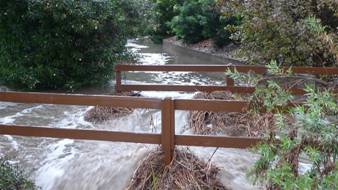
Photo credit: Tom Lemon
Safety tips from the nonprofit FLASH
March 1, 2014 (San Diego)--With much needed rain expected over the next few days, residents should take precautions to protect their home and family from the possibility of flooding. Eighteen to 24 inches of moving water can wash an SUV off of the road. In fact, according to the National Weather Service, more than half of all flood-related deaths are people driving through flooded roads. The nonprofit Federal Alliance for Safe Homes (FLASH) reminds residents to “Turn Around, Don’t Drown!” and offers the following safety tips to protect your home from costly flood damage.
Before the Flood
All it takes is a few inches of water to cause major damage to your home and its contents.
- Clear yard of any debris, plant material or items (garden décor, foliage, or garbage cans) that can block water flow and storm drains.
- If time permits, secure and/or elevate outdoor appliances, AC units or storage tanks.
- Place important papers (birth/marriage certificates, passports, bank and insurance information) in a watertight container. Take photographs or videos to create an inventory of your personal possessions and keep the camera card handy in case of evacuation.
- Identify and move electronics and other expensive items (computers, televisions, phone systems, area rugs, expensive furniture) on lower levels of the home and elevate if possible to keep them dry.
- When using sandbags be sure to fill one-half full, fold the top of sandbag down and rest bag on its folded top.
- Limit sandbag placement to three layers, unless stacked up against a building or sandbags are placed in a pyramid. Tamp each sandbag into place, completing each layer prior to starting the next layer.
- Clear a path between buildings for debris flow and lay a plastic sheet in between the building and the bags to control the flow and prevent water from seeping into sliding glass doors.
During the Flood
- Avoid flooded areas or those with rapid water flow. Do not attempt to cross a flowing stream. It takes only six inches of fast flowing water to sweep you off your feet.
- Don’t allow children to play near high water, storm drains or ditches. Hidden dangers could lie beneath the water.
- Flooded roads could have significant damage hidden by floodwaters. Never drive through floodwaters or on flooded roads. Water only one foot deep can float most automobiles.
- Be especially cautious at night when it is harder to see flooded roads.
After the Flood
- Take photographs of damage throughout the building and around the property. Assess stability of plaster and drywall. Bulging or swelling ceilings indicate damage. Press upward on drywall ceilings. If nail heads appear, drywall will need to be re-nailed but can be saved.
- Check foundation for any loose or missing blocks, bricks, stones or mortar.
- Empty basement water at a rate of about one-third per day to avoid structural damage to foundation by rapid pressure change.
- Clean and disinfect heating, air conditioning and ventilation ducts before use to avoid spread of airborne germs and mold spores. Use fans and sunlight to dry out interior spaces. Remove all wet carpets, curtains and fabrics. Allow to air dry completely.
To learn more about how much flooding can cost you check out this cost of flooding tool provided by FloodSmart. For more home and family safety tips visit www.protect-your-home.
About FLASH
Federal Alliance for Safe Homes (FLASH)®, a 501(c)3 nonprofit organization, is the country's leading consumer advocate for strengthening homes and safeguarding families from natural and manmade disasters. FLASH collaborates with more than 100 innovative and diverse partners that share its vision of making America a more disaster‐resistant nation including: BASF, Federal Emergency Management Agency, Florida Division of Emergency Management, The Home Depot®, International Code Council, Kohler® Generators, National Weather Service, Portland Cement Association, RenaissanceRe, Simpson Strong-Tie®, State Farm™, USAA® and WeatherPredict Consulting Inc. In 2008, FLASH opened the interactive weather experience StormStruck: A Tale of Two Homes® in Lake Buena Vista, FL. Learn more about FLASH and gain access to its free consumer resources by visiting www.flash.org or calling (877) 221- SAFE (7233). Also, get timely safety tips to ensure that you and your family are protected from natural and manmade disasters by subscribing to the FLASH blog – Protect Your Home in a FLASH.







Comments
Safety measures for potential flooding